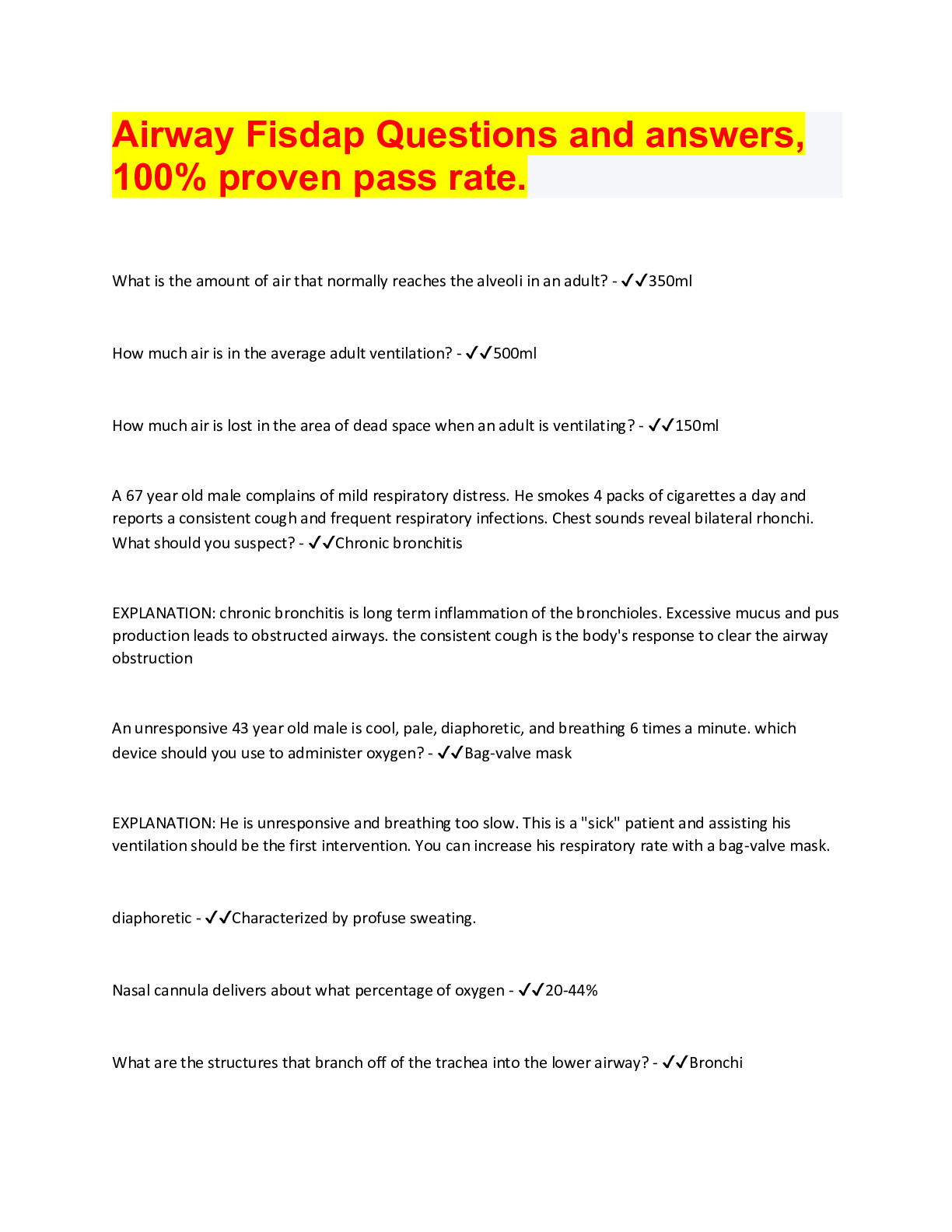*NURSING > QUESTIONS & ANSWERS > Cardio QBANK #2 Questions and answers, 100% proven pass rate. (All)
Cardio QBANK #2 Questions and answers, 100% proven pass rate.
Document Content and Description Below
Cardio QBANK #2 Questions and answers, 100% proven pass rate. A 67-year-old man comes to the clinic complaining of steady, dull back pain over the past 3 weeks. He states that he has recently mov... ed after retiring from a career in banking and is searching for a new health care provider. His past medical history is significant for diverticulosis, prior smoking, and hypertension. He says that he has run out of his blood pressure medication. He denies trauma to his back and otherwise feels well. On physical examination, his blood pressure is 170/93 mm Hg with a pulse of 88/min. He has no tenderness over the spinal processes or paraspinal areas. His abdomen is obese, but there is a suggestion of a non-tender, pulsatile mass in the epigastric region. The remainder of the physical examination is normal. Which of the following diagnoses should be considered at this time? - ✔✔AAA (Abdominal Aortic Aneurysm- The combination of the history of hypertension and smoking, the new back pain, and a pulsatile mass on examination is highly suggestive for abdominal aneurysm. Additionally, he is a male older than 65 years of age, which also puts him at higher risk for AAA development. The hallmark of ____________ is sudden onset, severe chest and abdominal pain that often radiates from an anterior to posterior direction. The pain is classically described as tearing in quality. Hypertension and trauma are common precipitants for this condition. - ✔✔Aortic Dissection (a common aortic catastrophe requiring admission to the hospital. This condition results from an extension of an intimal tear in the wall of the artery.) ___________- is also important to recognize, as it is a neurologic emergency. It is caused by compression of the lower lumbar and sacral nerve roots, however, and produces sensory loss in a *+saddle distribution, decreased reflexes, urinary incontinence, and flaccid and weak legs* - ✔✔cauda equina syndrome ___________- should be considered in older males, smokers, and patients who have atherosclerosis who have a palpable mass in the abdomen. It is often found incidentally when the patient has an imaging procedure on the abdomen as part of evaluation for another abdominal condition. Risk for rupture is highly dependent on the diameter of the aorta. Elective repair is recommended for males who have a >_____-cm and females who have a >____-cm diameter. Elective surgery has a much better prognosis than when Rupture Occurs - ✔✔AAA, 5.5, 5 (Abdominal aortic aneurysm) A patient who is being treated for hypertension related to a myocardial infarction that occurred 2 hours ago is medicated with IV nitroprusside (Nipride). Which of the following is the expected action of this drug? - ✔✔Dilatation of Arterioles and Venules (Nitro IV has rapid onset and used in ER & ICU. It can be titrated to effect on Drip-to-Drip basis. Nitro is on ACLS Protocol as well as Labetolol for HTN Emergency/Urgency. __________- can improve perfusion of vital organs and reduce the workload of the heart because it is both an arteriolar and venodilator. Problems sometimes encountered with this drug include hypotension (best avoided by starting with a low dose and continuously monitoring systemic arterial and pulmonary capillary wedge pressures) and accumulation of toxic metabolite (thiocyanate) of cyanide in patients who have liver or renal failure. - ✔✔Nitroprusside _________ and ________- are parenteral agents indicated for treating hypertensive urgency and hypertensive emergency. They may also be used to treat hypertension that is related to sympathomimetic drug use (such as cocaine, amphetamines, phenylpropanolamine, MAO-related hypertensive crisis). As a potent arterial and venous dilator, it is able to reduce both preload and afterload. It is typically administered with a beta-blocker, because its potent nitroprusside-induced vasodilation induces a strong compensatory tachycardia that might increase stress to the system. - ✔✔Nitro and Labetolol (Sodium nitroprusside and Labetolol) A 22-year-old man comes to the emergency department with a 3-day history of fever, chills, a cough, pleuritic chest pain, and low back pain. He says that the symptoms came on "out of the blue." He is the son of a wealthy local businesswoman and still lives at home, which he says "is cool because my parents are never around." His temperature is 39°C (102.2°F), blood pressure 120/80 mm Hg, pulse 70/min, and respirations 16/min. Physical examination shows oval retinal hemorrhages with a clear, pale center and pinpoint lesions between his toes. Blood cultures are drawn. A chest radiograph shows multiple patchy infiltrates. Laboratory studies show hemoglobin 11 g/dL, hematocrit 39%, and erythrocyte sedimentation rate 39 mm/h. Which of the following is the most likely pathogen? - ✔✔Staph aureus (This patient has acute bacterial endocarditis, most likely caused by Staphylococcus aureus, the most common organism causing endocarditis in intravenous drug abusers. The "pinpoint lesions" between his toes are signs of injection drug abuse. Acute endocarditis in drug abusers typically presents with a high fever, pleuritic chest pain, and a cough. The tricuspid valve is commonly affected in these patients) Sx of ___________- +Roth spots are oval, pale, retinal lesions that are surrounded by hemorrhages. +Janeway lesions, which are hemorrhagic, painless, macular plaques typically located on the palms and soles, +Osler nodes, which are small, painful nodular lesions typically found on the pads of the fingers or toes. - ✔✔Endocarditis _______________- is an infection that involves the endocardial surface of the heart and includes the valves. If the patient is symptomatic, presentation includes +fever, tachycardia, and fatigue. The patient may have a new-onset heart murmur or a change in the previously heard heart murmur. Echo should be performed in all patients suspected of having this. Three sets of blood cultures should be performed to identify the pathogen. Injection drug users are at high risk for _________ infection leading to infective endocarditis. - ✔✔Endocarditis, Staph Aureus (Infective endocarditis) A 29-year-old man is brought to the emergency department in a comatose state a few hours after complaining of sudden onset of excruciating headache. His friend does not know if the patient has any underlying medical conditions. Neurologic examination reveals dilated pupils poorly responsive to light. A CT scan of the head without contrast demonstrates hyperdensity within the suprasellar cistern, whereas MRI scan is unremarkable. Lumbar puncture shows hemorrhagic cerebrospinal fluid. Which of the following is the most likely diagnosis? - ✔✔Ruptured Berry Aneurysm (Rupture of a berry aneurysm is the most common cause of subarachnoid bleeding.Berry aneurysms develop as a result of congenital weakness at branching points of the arteries in the circle of Willis. These outpouchings tend to expand progressively, but in most cases they remain asymptomatic. Hypertension facilitates development and rupture of berry aneurysm. One third of patients recover, one third die, and one third develop re-bleeding. Rapid onset of coma is an ominous sign.) Headache of sudden onset ("thunderclap" headache), rapid deterioration of mental status, and blood in the CSF are virtually diagnostic of ruptured ____________. - ✔✔berry aneurysm Rupture of a berry aneurysm is the most common cause of ___________________. Berry aneurysms develop as a result of congenital weakness at branching points of the arteries in the circle of Willis. These outpouchings tend to expand progressively, but in most cases they remain asymptomatic. Hypertension facilitates development and rupture of berry aneurysm. One third of patients recover, one third die, and one third develop re-bleeding. Rapid onset of coma is an ominous sign. - ✔✔Subarachnoid Hemorrhage The congenital form of _______ aneurysm formation has an association with polycystic kidney disease, Marfan disease, Ehlers-Danlos syndrome, and neurofibromatosis. - ✔✔berry (congenital weakness at branching points of the arteries in the circle of willis) A 59-year-old man chooses a health care provider. The health care provider discovers that the patient was recently admitted to the hospital for palpitations and was found to have newly diagnosed atrial fibrillation (AF). He was placed on digoxin (Lanoxin) and verapamil (Calan, Isoptin, Verelan) for rate control and was loaded with warfarin (Coumadin) for anticoagulation. After several trips to the anticoagulation clinic, he decided to stop taking his warfarin, as it was difficult for him to leave work during the day. He now calls the office complaining of a cold, pale, and painful right leg starting an hour ago. Which of the following is the most likely explanation for his symptoms? - ✔✔Thromboembolism (Overall, atrial fibrillation confers about a 1% annual risk for a thromboembolic event, which, among other things, may cause stroke, intestinal ischemia, renal infarcts, or a threatened limb. Specific etiologies of AF such as valvular disease are associated with higher rates of embolic events.- NO DVT! This is an Arterial problem from thromboembolism) One complication of atrial fibrillation is a ___________ event that occurs as a result of a clot being expelled from the left atrium. This arterial clot may be manifested by signs of poor perfusion to the peripheral vascular system. The signs of acute clot include the "6 Ps": pain, pallor, paresthesias, paralysis, pulselessness, and poikilothermia. The patient's clot needs to be urgently addressed to salvage the tissue distal to the site of arterial obstruction. - ✔✔thromboembolic The signs of acute arterial embolism include the "6 Ps": +__________ - ✔✔pain, pallor, paresthesias, paralysis, pulselessness, and poikilothermia An arteriogram is performed on a patient who has atherosclerosis. Luminal narrowing of which of the following vessels would compromise blood flow through the renal arteries? - ✔✔Abdominal Aorta (The renal arteries emerge from the abdominal aorta at about the level of the L1/L2 intervertebral disk and travel at nearly right angles to it-on the right, passing posterior to the inferior vena cava- to enter the hilum of the kidney) ___________ artery- gives off the superior rectal, sigmoid, and left colic arteries. Occlusion to this artery causes acute bowel ischemia - ✔✔inferior mesenteric _________- gives off the common hepatic, splenic, and left gastric arteries. This artery primarily supplies blood to the colon - ✔✔celiac trunk ___________ artery- gives off the inferior pancreaticoduodenal, intestinal (ileal and jejunal), right colic, middle colic, and ileocolic arteries. Occlusion of this artery causes acute bowel ischemia - ✔✔superior mesenteric A 77-year-old man comes to the health care provider because of decreasing exercise tolerance. Just 1 year earlier he was able to play doubles tennis for 2 hours. Over the past few months, however, he has had progressive dyspnea on exertion and now can walk only 2 blocks on level ground before becoming short-winded. He has also been awaking from sleep with shortness of breath and requires 3 pillows to sleep comfortably. He has a history of rheumatic fever as a teenager. On physical examination his blood pressure is 168/60 mm Hg, pulse 92/min, and respirations 18/min. He is afebrile. He has jugulovenous distention lying supine. He has bibasilar rales extending 1/4 up both posterior lung fields. He has a regular S1 and S2, with a blowing diastolic murmur heard at the aortic area, which is grade II/VI. An S3 is audible. The liver edge is mildly tender, and there is moderate lower extremity edema extending to both knees. Which of the following medications will most likely be effective in the management of his cardiac disorder? - ✔✔Catopril (ACE- physical findings of aortic insufficiency and the development of congestive heart failure with biventricular failure. Left ventricular symptoms described here are the findings of pulmonary congestion, and right-sided heart failure is demonstrated by the jugulovenous distention, congested liver, and peripheral edema. Because the "backward" failure symptoms are caused by regurgitant flow across the incompetent aortic valve, the most useful therapy would be afterload reduction with an ACE inhibitor such as captopril, which will also help to prevent cardiac remodeling as the left ventricle becomes overloaded from the increased amount volume of blood that occurs because of aortic regurgitation.) Aortic regurgitation may be helped by vasodilator therapy, which will act as afterload reducers. In addition to _________, pure vasodilators such as hydralazine and nifedipine can also be used. For patients who have ongoing symptoms who are surgical candidates, aortic valve replacement is performed when the disease decompensates - ✔✔ACE (ACE inhibitor) After an accident at work resulting in severe hemorrhage, a machinist is rushed to the emergency department. Which of the following sets of autonomic responses would be predicted in this patient? -_______ BP -_______ Pulse - ✔✔Decreased, Increased (After a decrease in blood pressure e.g., after a hemorrhage, one would expect an increase in sympathetic outflow and decrease in parasympathetic outflow. As a result of the hemorrhage, there would be less blood in the body to circulate, with resultant increase in heart rate, decrease in both blood pressure and gastrointestinal motility, and dilation of the pupils) Shock is a clinical condition in which there is inadequate organ perfusion and tissue oxygenation. It is classically associated with -____tension -____cardia -____pnea. - ✔✔hypo, tachy, tachy (The normal physiologic response to shock is to have sympathetic release of hormones, which will stimulate the heart to beat faster and stronger so that the volume of blood can be circulated faster and with more force to overcome the deficiency of the blood supply to the end organs and to improve perfusion.) First-line management of *shock* is _______--> If the patient does not respond --> ________ and colloids such as albumin can be used along with vasopressors, which can help to maintain the vascular integrity and can be used to continue to stimulate the heart. - ✔✔Fluids, Blood Transfusion (fluid resuscitation with crystalloids, Blood Transfusion-primarily to allow better release of oxygen to the tissues) Which of the following is an example of a prerenal cause of oliguria? - ✔✔Shock (not all oliguria is caused by intrinsic renal disease. Shock, of any etiology, is an example of a prerenal cause of oliguria in which poor renal perfusion leads to inadequate urine output.) -Acute glomerulonephritis, transplant rejection are examples of ________ causes of oliguria. -Bladder tumor and prostatic hyperplasia are examples of ________ causes of oliguria. - ✔✔Renal, postrenal A patient having _______ will have decreased perfusion to the kidneys. This decreased perfusion will cause the kidneys to compensate for this impaired blood flow by increasing the release of renin, which will then lead to the formation of angiotensin I, which gets converted to angiotensin II, and later conversion to aldosterone occurs. This will result in *vasoconstriction and retention of sodium*, which will retain water and conserve water loss from the body. - ✔✔Shock (The urine in these patients will have a low fractional excretion of sodium, which will be <1%. This low fractional excretion of sodium will help to preserve fluid in this shock state, which will permit more volume being available for the body to use.) A 70-year-old hypertensive man arrives at the emergency department complaining of shortness of breath. His history is significant for chronic hypertension, paroxysmal nocturnal dyspnea, and nocturia. Physical examination reveals evidence of pulmonary and peripheral edema. The patient is admitted, and furosemide is administered. A low-sodium diet is ordered. The purpose of this dietary restriction is to -_______ ________ water - ✔✔Reduce Extracellular This hypertensive patient has symptoms and signs of congestive heart failure (paroxysmal nocturnal dyspnea, nocturia, and pulmonary and peripheral edema), for which dietary ______ restriction is recommended to reduce water retention. - ✔✔Sodium A 45-year-old woman comes to the emergency department complaining of recurring episodes of chest pain that each last a few minutes since she awoke this morning. She denies shortness of breath, radiation of the pain, or chest pain on exertion. She reports that she had similar episodes within the last month. The patient states that she has been healthy otherwise, takes no medications, and has no family history of coronary artery disease. Her vital signs and physical examination are within normal limits. Electrocardiogram shows transient ST-segment elevation. Serial cardiac enzymes reveal no abnormalities over a 24-hour period. Cardiac catheterization shows no significant areas of plaque or stenosis. Which of the following classes of drugs may be most effective in this patient? - ✔✔CCB (Dx- Prinzmetal angina, or variant angina, is classically characterized by angina without the associated precipitating factors of angina pectoris. It is caused by a transient coronary artery spasm and displays a transient ST elevation on electrocardiogram. It usually has no other diagnostic findings. *Calcium channel blockers* have been shown to treat and prevent episodes of coronary vasospasm by decreasing contractility of cardiac muscle and producing vasodilation) _________ Meds- are useful in delaying the progression of renal disease in patients who have diabetes and in treating patients who have congestive heart failure, especially if they have impaired left ventricular function. - ✔✔ACE (ACE inhibitors) ___________- are appropriate agents in the management of angina pectoris because they decrease both heart rate and blood pressure and thus the heart's oxygen demand. They also reduce mortality in patients who have coronary artery disease and post-myocardial infarction. These agents do not prevent vasospasm, so they are NOT clinically indicated in the setting of variant or Prinzmetal angina - ✔✔Beta Blockers __________- recommended first-line treatment for mild to moderate essential hypertension. This class of drugs decreases blood pressure by decreasing sodium, blood volume, and afterload. These drugs also provide symptomatic relief for patients who have congestive heart failure - ✔✔Diuretics ____________-decrease peripheral vascular resistance and are used in the treatment of hypertension and benign prostatic hyperplasia. - ✔✔Alpha 1 Blockers ___________- is a cardiac condition that is primarily caused by vasoconstriction or coronary artery disease. These patients may have *transient ST-segment elevation* during the painful episode. *Cardiac enzymes remain normal*. Treatment consists of _______, which may be used to prevent or treat cardiac vasospasm. Lifestyle modifications should be used in all patients. - ✔✔Prinzmetal angina, CCB (or Variant Angina) A 59-year-old man with a history of myocardial infarction presents to his health care provider complaining of shortness of breath. On examination, his pulse is 110/min and his respiratory rate is 22/min. He has rales in both lung fields, a normal sinus rhythm with an S3 gallop, and 2+ pitting ankle edema. A chest radiograph reveals cardiomegaly, and his ejection fraction on echocardiogram is calculated at 37%. Which of the following medications would alleviate this patient's symptoms by significantly reducing both the preload and afterload on the heart without affecting its inotropic state? - ✔✔Enalapril (Everything in this case points to congestive heart failure -CHF- dyspnea, elevated heart rate, S3, peripheral edema, and reduced ejection fraction. A drug that will alleviate the symptoms by: *decreasing both preload and afterload is necessary*) In a patient with CHF what medication will you place them on if you need to BOTH: -Decrease Preload and Afterload - ✔✔ACE (captopril, enalapril, lisinopril, benazepril, ramipril) __________- work by blocking the conversion of angiotensin I to angiotensin II in the lungs. Angiotensin II is both a potent vasoconstrictor and a stimulator of aldosterone production. Aldosterone acts by promoting sodium (and thus water) reabsorption by the kidney. An ACE inhibitor will therefore promote vasodilatation (reducing afterload), as well as reduce intravascular volume (decreasing aldosterone, as less renin is being released). - ✔✔ACE (captopril, enalapril, lisinopril, benazepril, ramipril) Although _________ is a mainstay in the therapy of CHF, it has no effect on either preload or afterload. Instead it works by having a positive inotropic and negative chronotropic effect on the heart. The mechanism involves inhibition of Na+/K+ ATPase and a consequent increase in intracellular calcium, which in turn increases the heart's contractile force. - ✔✔Digoxin ________-it decreases intravascular volume (and hence preload), but at typical doses it has no significant effect on either afterload or inotropic state. They are often used in the treatment of CHF, and it is used for the immediate relief of pulmonary congestion. - ✔✔Loop Diuretics (Furosemide) _________- are first-line agents for patients who have heart failure because they act as vasodilators. They decrease afterload, which allows the heart to have improvement in its ejection fraction. They do NOT have an inotropic or chronotropic effect on the heart. There is a mortality benefit demonstrated with the use of these agents. - ✔✔ACE inhibitors (Beta-blockers and the aldosterone antagonist, spironolactone, also have been shown to have an improvement in mortality in patients who have chronic heart failure) A 61-year-old woman comes to the health care provider for her first physical examination in more than 10 years. She reports that she has been in excellent health, does not smoke or drink, and runs 3 miles daily. She is a retired accountant and has 3 healthy grown children. She has been taking 81 mg of aspirin daily after reading about its cardioprotective effects in the newspaper. On physical examination she appears well. Blood pressure is 122/76 mm Hg, pulse 70/min, and respirations 14/min. She is afebrile. Head and neck examination is normal. There is no jugulovenous distention. Lungs are clear. On cardiac examination she has a regular S1 and S2, and II/VI crescendo blowing diastolic murmur is heard at the aortic area. Abdominal examination is normal. Rectal examination shows no masses and brown, guaiac-negative stool. Which of the following most likely explains the cardiac findings on physical examination? - ✔✔Prior Strep Infection (findings of asymptomatic aortic insufficiency on physical examination. This lesion may result from a number of causes, several of which are infectious in etiology. Aortic insufficiency may result as a sequela of rheumatic heart disease, which occurs as an immunologic response to a streptococcal infection. Acute rheumatic fever is typically characterized by cardiac involvement that may cause pericarditis, myocarditis, or endocarditis. Often the initial cardiac manifestations are asymptomatic and become apparent only years later with the development of cardiac valvular disease) 12-year-old African American boy is brought to the office for a well child examination. He has been in good health and only complains of an occasional headache. He has been doing reasonably well in school but has some social problems that his mother attributes to his physical appearance. She has tried persuading her son to eat healthier, but he seems to enjoy eating fast food much more than home cooked meals. His past medical history is unremarkable, and the family history is significant for adult-onset hypertension in his father's family. He takes no medication. On physical examination, the patient is in no acute distress. He is 145 centimeters tall and weighs 92 kilograms. His vital signs are within normal limits, but his blood pressure is 145/90 mm Hg. The health care provider checks that the cuff size is appropriate and remeasures his blood pressure in all four extremities, only to confirm that it is above the ninety-fifth percentile for his age. After discussing the finding with his mother, he is scheduled for several more blood pressure evaluations over the following 6 weeks. All readings yield results mildly above the ninety-fifth percentile for his age. Which of the following recommendations is most appropriate at this time? -1st _________, _______ and _______ - ✔✔Lose Weight, Decrease Sodium and Exercise (Dx- Systemic HTN is BP > than 95% percentile for Age on repeated measurements over 6weeks. Therapy of hypertension in children is the same as in adults: diet, exercise, and medication. Pharmacologic management includes angiotensin-converting enzyme inhibitors, calcium-channel blockers, and diuretics.) Which of the following medications is the most appropriate choice for the treatment of hypertension during pregnancy? - ✔✔Methyldopa (alpha 2 agonist, decrease BP by Decreasing Peripheral Vascular Resistance. *Drug of Choice for Tx HTN during Pregnancy that may lead to Pre-Eclampsia.) A 54-year-old man comes to his health care provider complaining of intermittent palpitations. The patient reports that a few times over the past few months he has had episodes of "pounding in his chest" that are associated with shortness of breath and occasional chest pain. He is forced to sit down if he is standing, because of weakness and vertigo. The patient has a history of hypertension and mitral valve prolapse. He takes nifedipine (Procardia, Adalat) and hydrochlorothiazide daily. While sitting in the office, the patient begins to complain of increasing shortness of breath and palpitations. His blood pressure is 85/50 mm Hg and his pulse is 110-130/min and irregularly irregular. Which of the following is the most appropriate management at this time? - ✔✔Call 911 (patient has acute atrial fibrillation-AF- with rapid ventricular response-RVR- and is consequently hypotensive. This is a *medical emergency*. Even the PCP Cannot Deal with a potentially life-threatening episode of AF with RVR. Activating the emergency medical [Show More]
Last updated: 1 year ago
Preview 1 out of 29 pages
Instant download
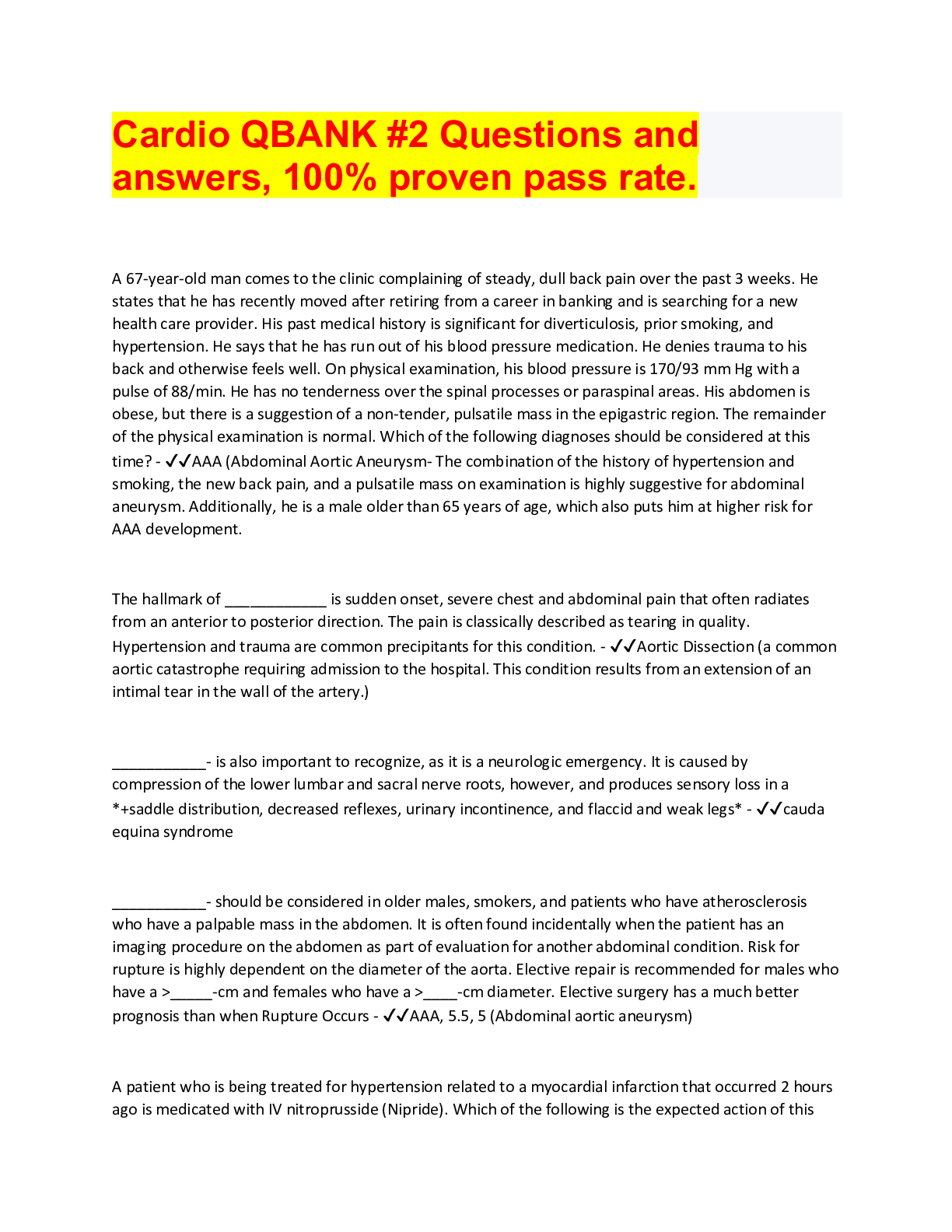
Buy this document to get the full access instantly
Instant Download Access after purchase
Add to cartInstant download
Also available in bundle (1)
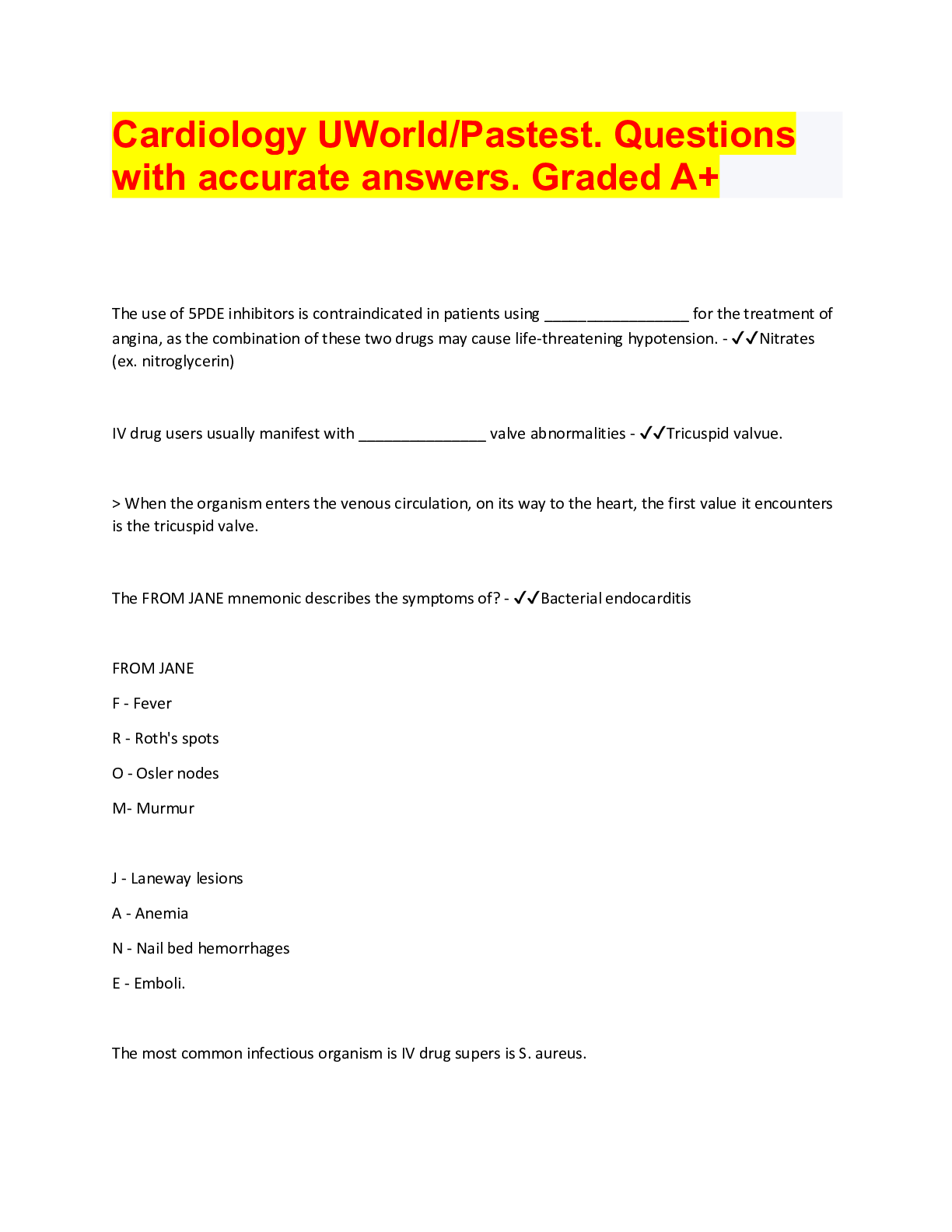
Cardiology BUNDLE, Questions and answers
All Cardiology exam papers questions with answers, download to score
By bundleHub Solution guider 1 year ago
$29
7
Reviews( 0 )
Document information
Connected school, study & course
About the document
Uploaded On
Aug 21, 2022
Number of pages
29
Written in
Additional information
This document has been written for:
Uploaded
Aug 21, 2022
Downloads
0
Views
84
















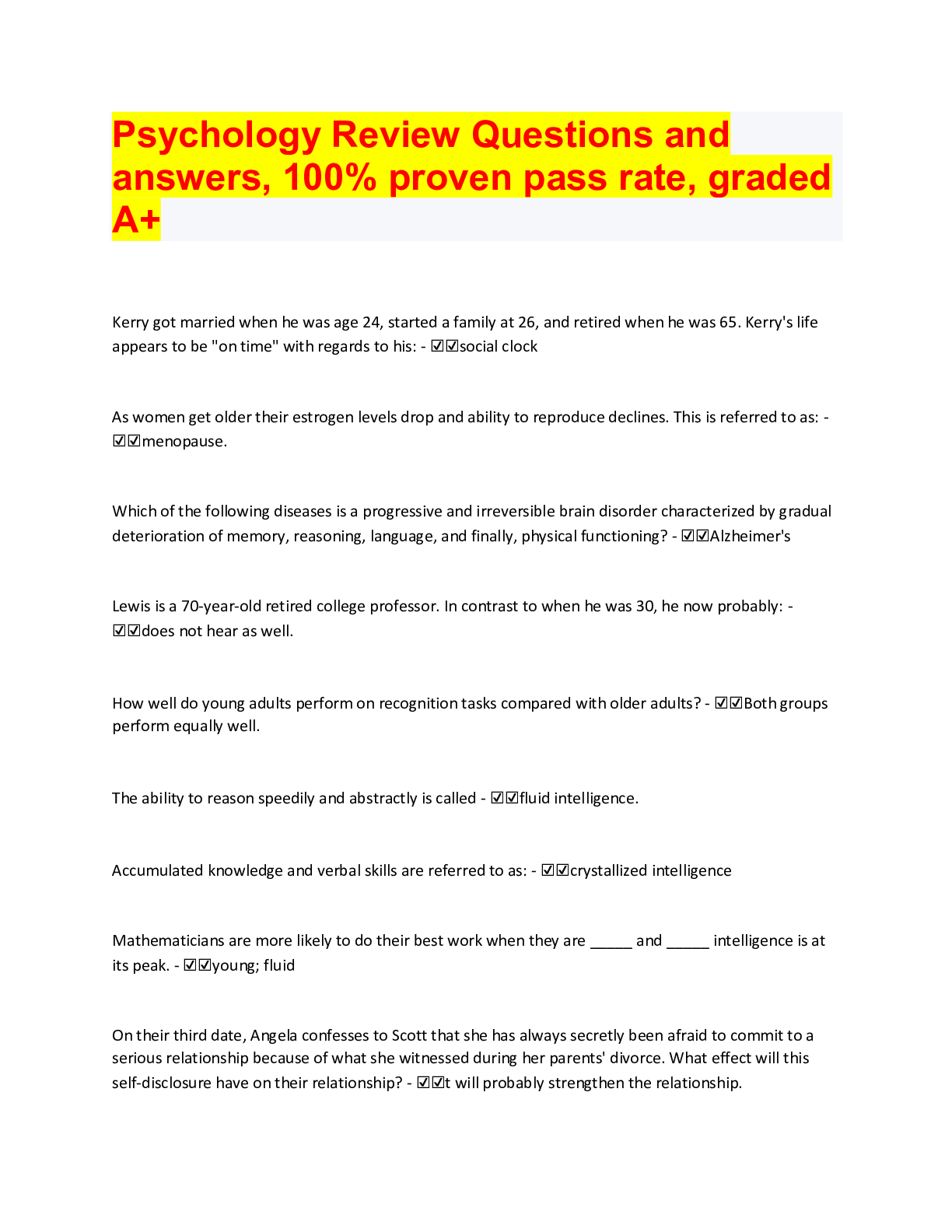
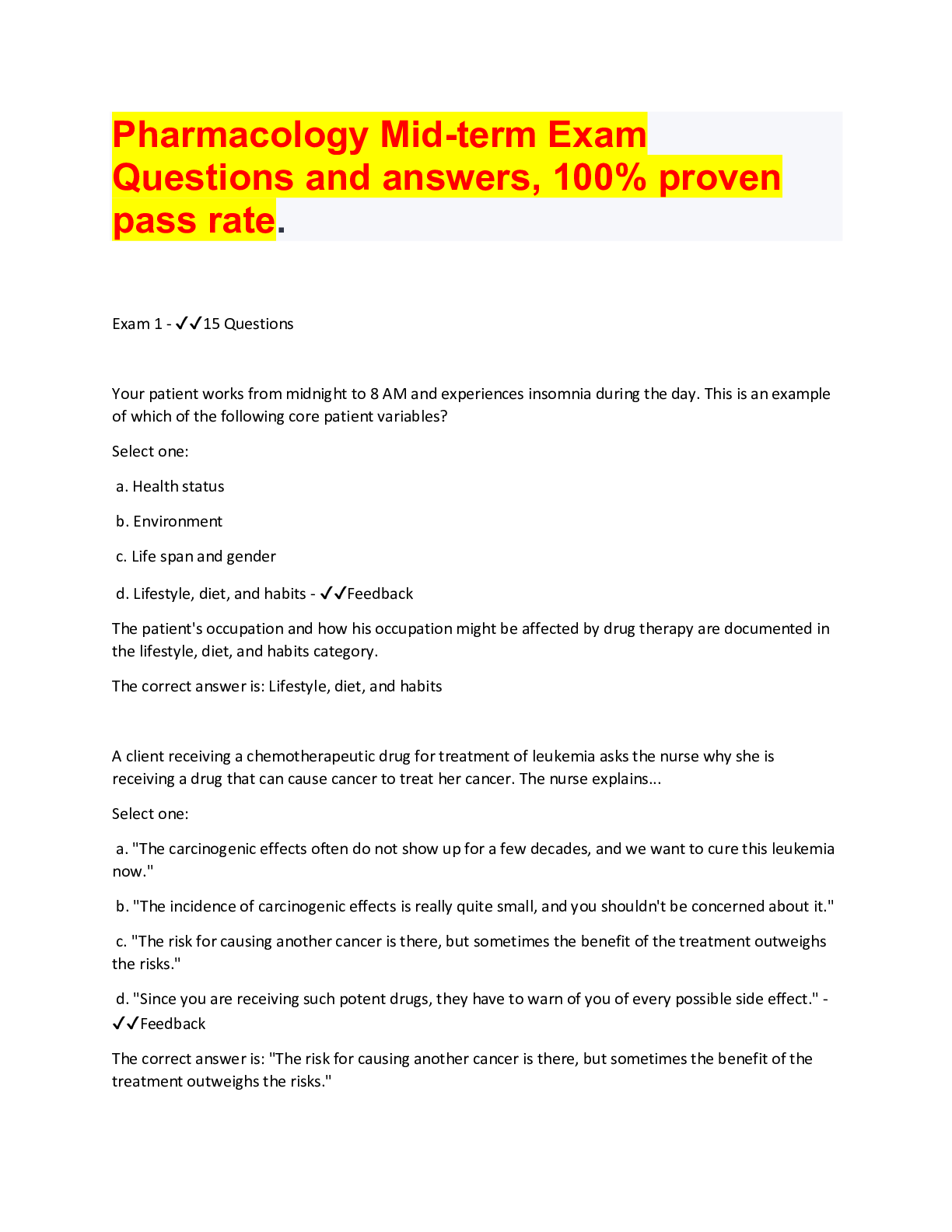
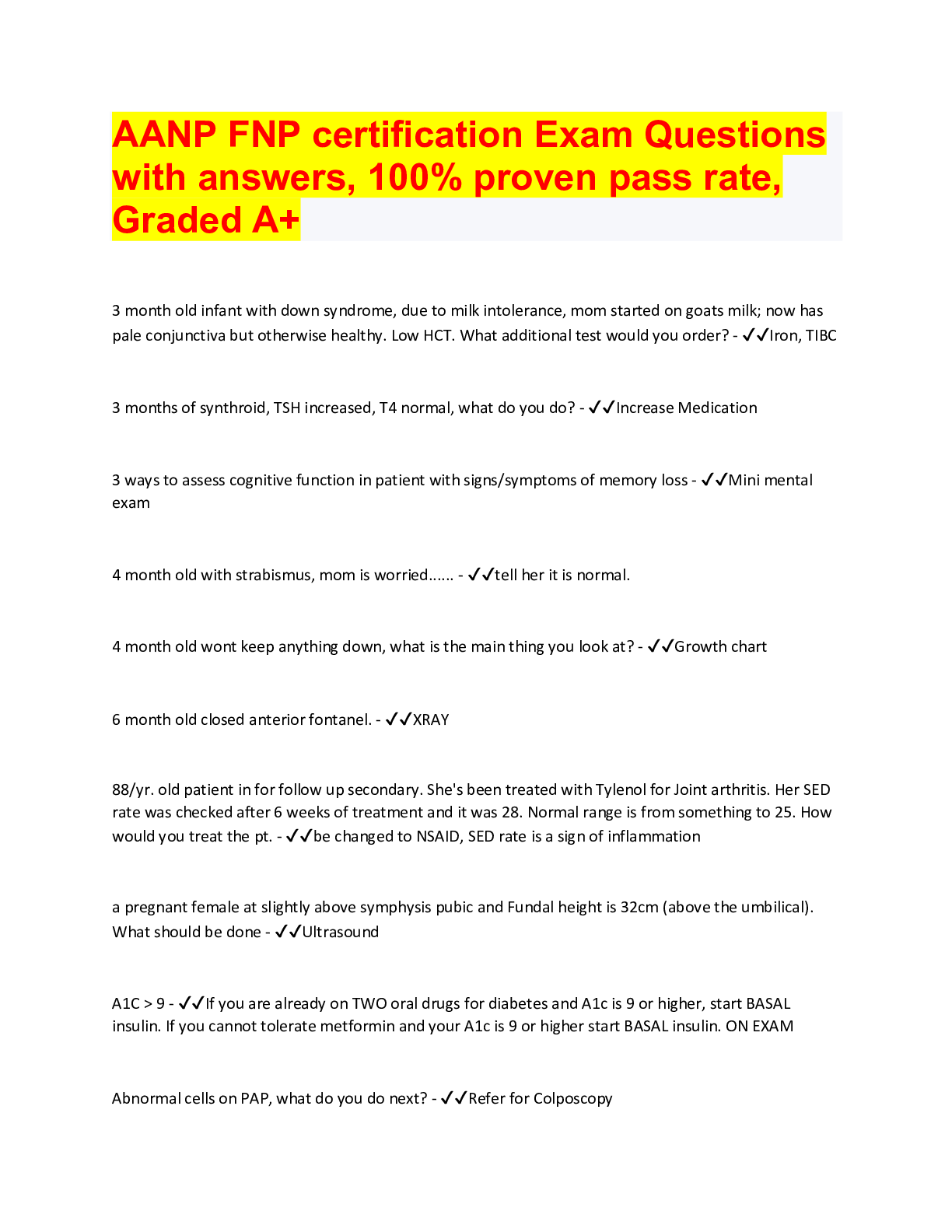



.png)
